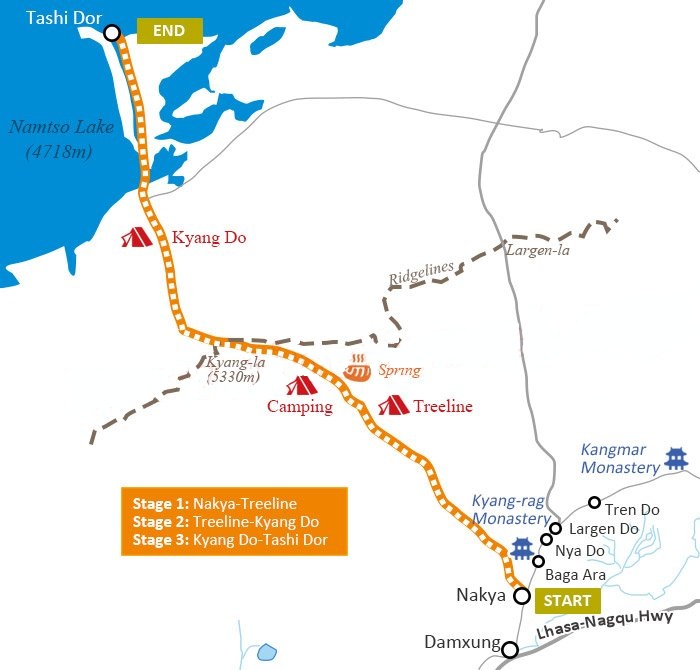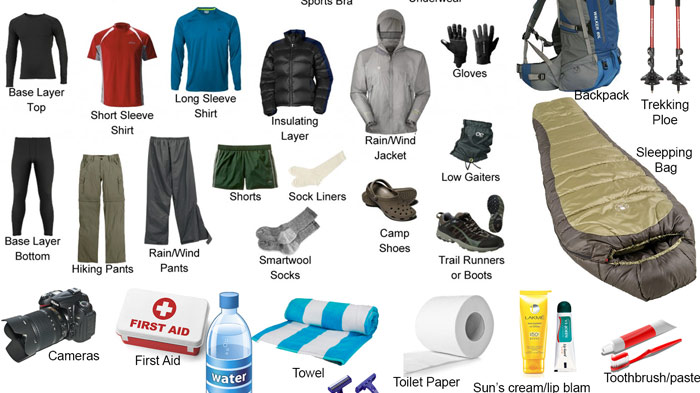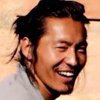
Namtso Lake Trekking: Expert's Guide to Trekking to Namtso
If you have conquered majestic mountains or steep ravines, and begin to hunt for other places which you expected to be utterly exotic, or you never experienced a trekking tour on the plateau, the Namtso Lake Trekking will never make you feel disappointed, for this trek is typically considered as the fabulous one for those who want to explore the ecological mosaic of northern Tibet.
Namtso Trekking Overview
Duration: 3days
Distance: 60km
Start: Damxung
Finish: Tashi Dor
Highest Point: Kyang-la (5330m)
Accommodation: camping
Highlights of the Trek
1. Pass through lower and higher valleys; enjoy the gorge landscape
2. Climb up the forested slopes ascending from the gorges; appreciate the constantly changing sceneries and plant covers.
3. Set foot on the sacred alpine meadows and embrace the plains of the Changtang
4. Get a close-up view of the Namtso Lake and taste its holiness; revolve around the lake and pray for good things
5. Camp outside in Tibet at night and relax under the starry sky
The trekking is actually a long-awaited walk for those who interested in the ecological diversity of northern Tibet. Located 160km away from Lhasa, Damxung County which is featured by rugged terrain and constantly changing climate has an average altitude of 4200m and becomes the starting place. The trek begins on Damxung’s main road and makes a round about to cross the mighty Nyenchen Tonglha Mountains to Namtso Lake.
 Enjoy the scenic trekking around Namtso Lake
Enjoy the scenic trekking around Namtso Lake
With the road wending its way through a rocky defile, the sceneries have been changing constantly from a canyon landscape to an attractive meadow with a number of streams running by and the gate to a high-elevation forest. On the way, the swaying dwarf willows and flaming flowers like rhododendron dominate the entire space, eagerly showing their gorgeousness and hidden beauty to all the explorers passing by. A tundra-filled upper valley gradually climbs to the Kyang-la (Onager Pass), followed by a steep descent onto the Changtang Plains. A distant but fantastic scenery of Namtso and Tashi Dor can be viewed on the trail with colorful camps scattering around, making the Namtso trekking tour much more splendid.
What will we do before getting started?
Every great expedition comes from a thoughtful arrangements. Before this high altitude trekking, getting everything perfectly arranged seems to be the utmost. The first thing you need to do is to acclimatize the high altitude. So arriving in Lhasa two or three days before the trek and get contact with your tour guide in advance. Visit some eminent places in Lhasa for sightseeing and check out what trekking gears you haven’t prepared back home. (Find the recommended trekking gears you need to equip underneath). Feel free to consult our travel guru to make sure everything has been prepared.
Detailed day by day itinerary of Namtso trek
 Namsto Trekking Map
Namsto Trekking Map
Day 1: Damxung to the Treeline (5-6 hours/18km/480m ascent)
The first trail of the trek sets off from village outside Damxung County. With the main road penetrating directly into the Kyang Valley, sceneries begins to change and finally we begin our trekking. All the way to the Kyang-la (the highest point along the trekking, 5330m), the valley keeps running in a northwest direction. After one hour from Kyang-rag Monastery (a monastery 50m above the northeast side of the Valley), we ford the crystal waters of Kyang-chu to the west side of the valley and enter a narrow rocky gorge. The gorge adjoins with the undulating high mountains that close in around the Kyang-chu. What awaits us are five more fords. The Kyang-chu is actually a simply shallow stream but with swift current, so just mind your steps.
This trail is not that hard to follow. In 10 minutes, it crosses to the east side of the valley. Gravels and rocks are everywhere, so it’s better to get your feet wet in case of slippery. Within half an hour, the trail breaks out the gorge at the last ford and lands on the east sides of the valley. The valley is now turning to be a little open with west slopes heavily forested, but still leaving the trail in the valley bottom or along the east edge of the slope. After 2 and a half hours’ trekking, we finally arrive at the Treeline. Not being occupied by the shepherds, you can easily find a number of places to camp.
The first day’s trek will definitely bring you the long awaited excitement and pleasant surprises, but caring more about your body condition and having a good sleep will help you recover from the fatigue and ensure you a good condition to challenge the rest sustainable trekking. Just relaxing early in the tent and avoid chasing around.
Day 2: Treeline to Kyangdo (8-9 hours/25km/540m ascent/490 descent)
The second trail must be the most physically consuming trail in the whole trekking, since we will face the Kyang-la which has an altitude of 5330m and the trekking time extends to 8-9 hours. Continue to march forward until the protruding base of a cliff leaping into eyes. The majestic sceneries start to rise, for we begin to enter the tundra zone. The oxygen content tends to be declined. Have a short rest and take a smooth breathing. When you realize the valley becomes wandering and steeper, stay in valley floor and head upstream. After about 50 minutes’ walk, we encounter a long but wide branch of the valley stretching towards its east flank. It takes approximately one and a half hours to trek over the stretch of the valley.
The solemn rolling peaks of Nyenchen Tanglha Range stand upright above your head. From this point of view, drokpa camps can scarcely be found, for we are approaching the Kyang-la. As we explore upward, the valley becomes narrow and steeper. After about 2.5 hours’ trekking, we finally meet the base of Kyang-la (5240m). The trail maintains in northwest direction and we continue to climb up. After 45-minute hike from the base, we reach the high point Kyang-la.
Fill the bottles with good drinking water at the head of Kyang valley which is about 30m descent from the high point. Then the valley bends to the north and the trail stretches all the way down to the Namtso basin. Soon, the great holy lake in all its splendor comes into focus. With 5 big uninhabited islands in its center and approximately 1500 lakes scattering around, Namtso Lake is taken as the meditation and spiritual retreating place for pilgrims all over the world. Believers and travelers pray for good health and lucky things by revolving round the Lake. Few minutes later the trail deeply descends through rocky slopes, followed by grassy slopes. In about 45 minutes, we reach the valley floor (5120m), with the magnificent Tashi Dor coming into full view. Then continue to go downward, we eventually reach Kyangdo. We have the starry sky on heaven while the holy lake on earth. Camp at the riverside and take an early rest.
Day 3: Kyang Do to Tashi Dor (4-5 hours/17km/80m descent)
After reaching the base of the hill by hiking across the plain, we begin heading for Tashi Dor. Swampy ground spreads along the trail and leaves many things for sightseeing. Keep trekking to find a complex of mainly white buildings to the north. Then trekking direct to it will make us soon arrive at Tahi Dor. The tourist center is just 8km away on a black-top road.
When is the best time to trek this route?
The best time to trek this route is no doubt from May to October. During these months, plants grow lushly along most of the trek trail with plenty of diversity. The yak doted meadows send out pleasant fragrance while the scarcely seen birds perch on the forested slopes. The whole trekking trail is full of vitality. However, when the winter season comes, typically from November to early February, the trekking route turn to be another view. Most of the trekking areas hang over with white mist while the diversified plants are all devoured by the heavy snow. Mountains and even most of the main roads that take you to the trial head have been blocked. Plants along this trek trail flourish in July and August, so it makes this trek the hottest among others. Drive carefully, for the road condition tends to be messy during these two rainy months in Tibet. - Check Namtso Lake Weather and Climate
What should we pack before the trekking?
Trekking in Tibet has not always been so easy, since the high altitude and constantly changing and unexpected trail conditions. So good preparations in advance can save you a lot of time and energy during the trekking. Here we present you the trekking gears and must-have packing equipment to make this preparation easy. Choose to trek in Tibet, sweaters, winter jackets, gloves, sunglasses and trekking boots must be prepared in advance. A rain jacket can prevent you from the unexpected rain. A suitable hat is also recommended for not being hurt by the intense sunshine. Poles should never be out of your preparation for its undoubted convenience in the whole process. A comfortable big backpack should really be essential for you.
 Part of the trekking equipment you need to prepare
Part of the trekking equipment you need to prepare
Besides the mentioned wearing you need to consider, some other helpful stuffs also worth your time to prepare. Due to the intense sunshine and dry weather, moisture and sunscreen can keep you from the sustained UV radiation. If you plan a stay at a high altitude spot, the tent, pillows, insulation mat, hut sleeping bag, seat cushion and toiletries, medicine for high altitude sickness and a small first-aid kit are recommended to be packed in advance. Bring the gas tank with you, the tour guide can help you to cook every day. Don’t bother to bring a marked map, a sports watch, a compass and even a GPS-enabled device with you, since it is indispensable on extreme conditions. Flasks, drinking bottle with hydration system functions a lot and you can drink while walking. The rain gear, moisture-proof appliance can help you cope with the changing weather. For other must-have equipment, resort to our guide for more information.
Other Tips for trekking
1. Trekking independently in Tibet is not allowed according to Tibet travel policy. All foreign travelers are required to have a guide, a tour company itinerary, and a Tibet Entry Permit, all of which we can arrange for you.
2. Before trekking, take a thorough physical examination. Ensure a good body condition to take the challenge.
3. Transfer to the lower altitude place when suffering severe altitude sickness during the trekking tour.
4. Do not provoke wild animals along the trekking trials.
5. Prevent from drowning when wading the water, especially in rainy season.
6. Watch the trail you set foot on in case of slippery. Slipping from a high place happens all the time during high altitude trekking. Once fall, contact your group members immediately.
7. Stay with group members and do not try independent trekking during the tour. If you get lost, try to get in touch with your team members by the satellite phone.

Energetic, responsible and reliable, Sonam is a guide with more than seven years experience informing visitors about heritage sites and attractions places in Tibet.


.jpg)


0 Comment ON "Namtso Lake Trekking: Expert's Guide to Trekking to Namtso"